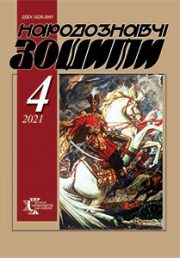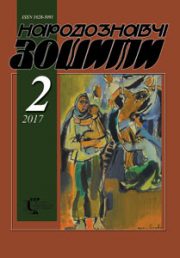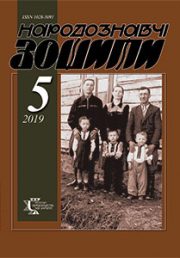The Ethnology Notebooks. 2018, 2 (140), 372—384.
UDK 391.4:687.38.03](477.85/.87)”19/20”
DOI https://doi.org/10.15407/nz2018.02.372
Received 20.02.2018
THE TRADITION OF BELTS` WEAVING ON AT HUTSULSHCHYNA IN THE XX — THE BEGINNING OF XXI CENTURY
ORCID ID: https://orcid.org/0000-0002-8742-4337
Kozakevych Olena Romanivna, Candidate of Art History, Researcher
of the Department of Folk Art
of the Institute of Ethnography of the National Academy of Sciences of Ukraine.
Svobody Avenue 15, 79000, Lviv, Ukraine.
Contacts: e-mail kozakevych.olena@gmail.com
Abstrakt. An attempt to explore the traditions of weaving and decorating hutsuls belts of the XX-th — beginning of the XXI-th century is made. Attention is focused on the unique and universal features of «mesh weaving» technology. The basis of the study of methods of wear, types, technological methods of production and artistic features of belts — author’s field research (2004—2017) and the processing of museum collections of different levels. The main stages of the existence of traditional woven belts in the Hutsulshchyna are determined; the centers of their production, local differences, and the names of the masters were recorded. One of the main practical results of the studios is the fixation of ancient and modern models of mesh weaving technology from the bearers of the tradition and the author’s attempt to reconstruct mesh webbed belts.
Keywords: folk clothes, belt, origins, Hutsulshchyna, comparative aspect, local features, weaving, mesh structure, coloring, decoration, versatility, uniqueness, tradition, reconstruction, mistress.
REFERENCES
Zdoroveha, N. (1868). Pletinnia chy brannia? Narodna tvorchist’ ta etnohrafiia, 2, 68—69 [in Ukrainian].
Kajndl’, R. (2000). Hutsuly: ikh zhyttia, zvychai ta narodni perekazy. Chernivtsi: Molodyj bukovynets’ [in Ukrainian].
Kozakevych, O. (2017). Lokal’ni osoblyvosti narodnoho odiahu «kol’orovykh» sil Nadvirnianschyny XX — pochatku XXI stolittia: porivnial’nyj aspekt (na pol’ovykh materialakh). Ukrains’kyj fenomen Hutsul’schyny: natsional’nyj ta ievropejs’kyj konteksty. Kolomyia: Vik [in Ukrainian].
Kozakevych, O. (2006). Kosivschyna — oseredok v’iazannia XX st. In Pratsi naukovoho tovarystva im. Shevchenka. Kraieznavstvo. (T. II. 270—280). Kosiv [in Ukrainian].
Kozakevych, O. (2011). Ukrains’ki tradytsijni v’iazani vyroby kintsia XIX —XX st.: lokal’ni osoblyvosti (za materialamy zakhidnykh oblastej). Zapysky Naukovoho tovarystva im. T.H. Shevchenka. (T. CCLXI (261). 503—524). Pratsi komisii obrazotvorchoho ta uzhytkovoho mystetstva. L’viv [in Ukrainian].
Kozakevych, O. (2014). Typolohiia ukrains’kykh narodnykh v’iazanykh ta merezhyvnykh vyrobiv XIX — pochatku XXI stolittia: vbrannia. The Ethnology Notebooks, 6 (120), 1403—1419 [in Ukrainian].
Kozakevych O. Brannia. In Pavliuk, S. (Ed.). Mala entsyklopediia ukrains’koho narodoznavstva. (pp. 65—66). L’viv : Afisha [in Ukrainian].
Kozakevych, O. (2014). Ukrains’ki narodni merezhyvni ta v’iazani vyroby kintsia XIX — pochatku XXI stolittia: Istoriohrafiia pytannia. The Ethnology Notebooks, 5 (119), 951—966 [in Ukrainian].
Kozakevych, O. (2002). Vplyv sotsial’no-politychnykh iavysch na rozvytok ta formuvannia ukrains’koi mody (v konteksti istorii zakhidnoievropejs’koho kostiuma). The Ethnology Notebooks, 1—2, 146—153 [in Ukrainian].
Kozakevych, O. (2013). Merezhyvni narodni vyroby na Volyni ta Polissi kintsia XIX— XX st.: rehional’ni osoblyvosti. Materialy Vseukrains’koi naukovo-etnohrafichnoi konferentsii «Mynule i suchasne Volyni j Polissia: narodna kul’tura i muzei», prysviachenoi 80-richchiu vid dnia narodzhennia Oleksy Oshurkevycha. Naukovyj zbirnyk. Luts’k [in Ukrainian].
Kozakevych, O. (2015). Tradytsijni v’iazani ta merezhyvni vyroby na Bojkivschyni i Pidhir’i kintsia XIX — pochatku XXI stolittia: vbrannia (za materialamy mystetstvoznavchykh ekspedytsij 2005—2006-kh rr.). The Ethnology Notebooks, 5 (125), 1127—1149 [in Ukrainian].
Sydorovych, S. (1979). Khudozhnia tkanyna Zakhidnykh oblastej URSR. Kyiv: Naukova dumka [in Ukrainian].
Charewiczowa, L. (1929). Lwowskie organizacje zawodowe za czasуw Polski Pzedrozbiorowej. Lwуw [In Polish].
Falkowski, J. (1938). Pуіnocno-wschodnie pogranicze Huculszczyzny. Prace Etnograficzne. Lwуw [In Polish].
Falkowski, J. (1937). Zachodnie pogranicze Huculszczyzny. Dolinami Prutu, Bystrzycy Nadwуrniaсskiej, Bystrzycy Soіotwiсskiej і Јomnicy. Lwуw: Towarzystwo Ludoznawcze [In Polish].
Kopernicki, I. (1889). O Gуralach Ruskich w Galicyi. Zarys etnograficzny wкdіug spostrzeџeс w podrуџy, odbytej w koсcu lata 1888 r. Krakуw [In Polish].
Loziсski, W. (1902). Patrycyat i mieszczaсstwo lwowskie w XVI i XVII wieku. Lwуw [In Polish].
Ukraintsi Pravoberezhzhia v natsional’nykh kostiumakh: foto 1870-kh rokiv. Foto: Tetiana Yatsechko-Blazhenko. Retrieved from: http://tyzhden.ua/Gallery/ (Last accessed: 17.01.2018)






